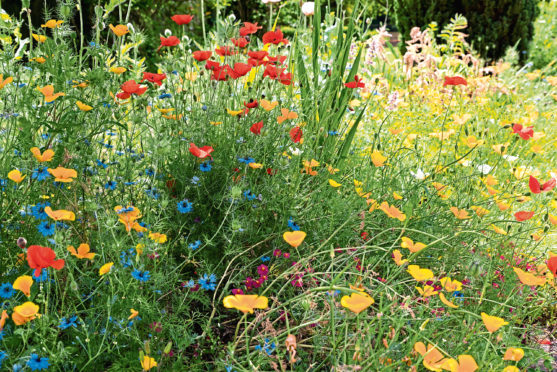
Digging about in the bottom of the tool bag where I keep trowels and plant labels, I came across a bundle of seed packets I’d forgotten about.
I couldn’t have been happier if I’d unearthed buried treasure. Most of the seeds were annuals, including poppies, cosmos and nigella, so I wasted no time in sowing them in seed trays and will move them on as they grow until they are big enough to plant in the borders and in containers.
If you’ve got any, then it’s worth sowing a few rows of them amongst the vegetables as their bright flowers will attract pollinating insects and provide stems for bringing indoors.
Meanwhile, I’ve been taking cuttings from the pelargoniums on the kitchen windowsill and, in a jar of water, I’m rooting cuttings of pineapple mint. I’ve talked before about how much I love this little herb, not just for its flavour but also because, as it grows, it spills over the side of the pot, making it great for hanging baskets that get a bit of shade. And mint roots readily in water and grows quickly when potted up.
There are many kinds of mint, so if you like a Mojito or mint tea then it is worth experimenting with varieties to produce different flavours and, if your garden gets little sunshine, then this is one herb that will definitely thrive.
In one sheltered corner of my garden I grow herbs that love to bake in the heat, including thyme, marjoram, rosemary and sage. I’ve got a fig tree here too, although I’ve yet to get any fruit. But on hot days it adds to the feel that this is a small slice of the Mediterranean.
It’s here I’ll grow the pelargoniums once they are large enough to go outside and it is here I keep the evergreen agapanthus that in summer send up long stems holding starry globes of blue and white flowers above strappy leaves.
I like to use all the micro-climates, from the damp area at the bottom of the slope where I’m naturalising bog plants in the grass to the mossy bank where I’m growing primroses and other meadow natives. Even the smallest garden can offer a range of conditions and you can alter these by creating a windbreak, trimming back trees to let in light or improving the drainage.
Often the gardens that most impress me are tiny spaces where giant plants blur the boundaries and lush foliage gives the impression of being in an oasis. These are proof the most important ingredient in any garden is imagination.
I’m still debating what to put in the corner where we used to have the compost heap or how to tackle the weed-strewn bank at the side of the house where we park the car. Maybe I should have sprinkled the flower seeds here and let the bright blooms cover my earlier mistakes.

Enjoy the convenience of having The Sunday Post delivered as a digital ePaper straight to your smartphone, tablet or computer.
Subscribe for only £5.49 a month and enjoy all the benefits of the printed paper as a digital replica.
Subscribe